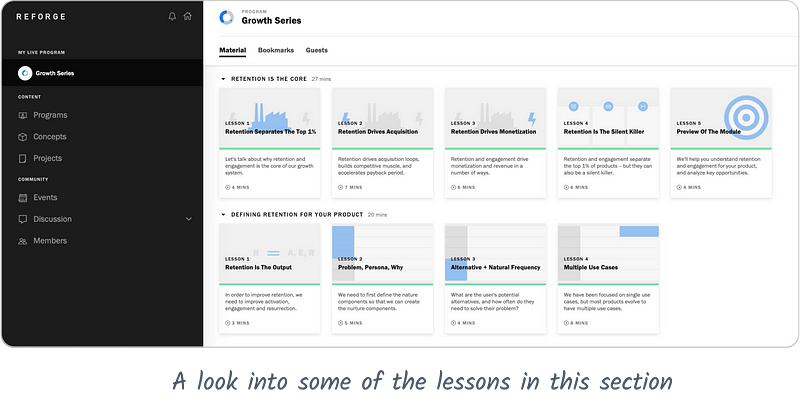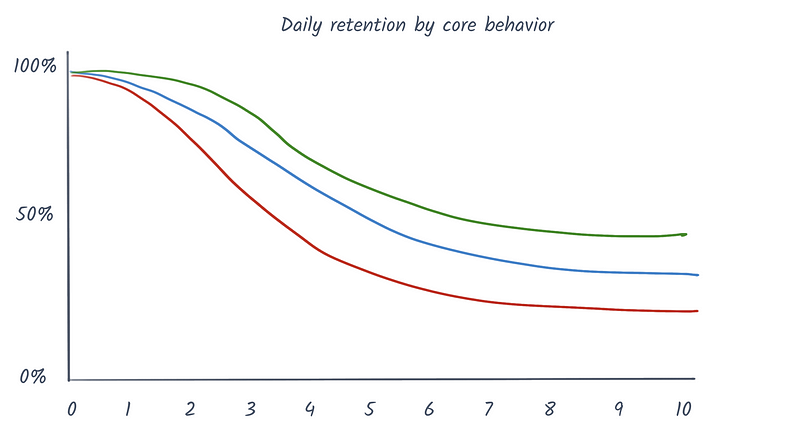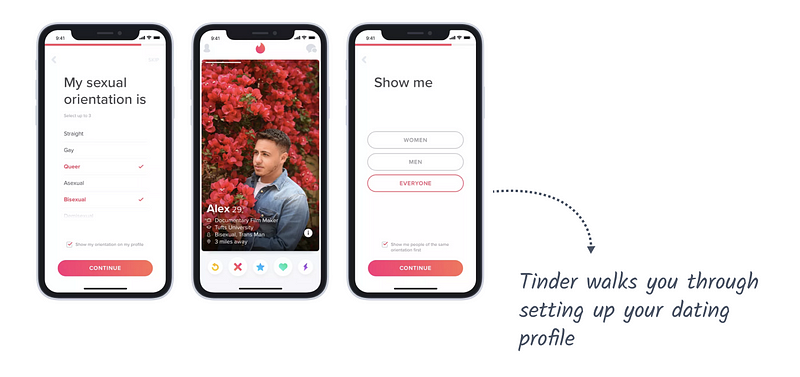📓 Reforge Recap: Engagement + Retention
Apr 13, 2021 • 7 min • Growth
I've been a fan of Reforge for a few years now, mostly interacting with the program through their blog posts. As far as product + growth thinking goes, it's tough to beat the stuff that they put out on a consistent basis.

Fast forward to now, I'm full-tilt on the product growth path and I'm excited to have enrolled in one of their Growth Series cohorts! As the course progresses, I'll be sharing my notes and reflections here.
As you might expect, the full Reforge course goes much more in-depth than I what cover here, so I highly encourage you to check it out if you can. First up, retention and engagement:
- Why retention matters: Provide messaging for why it should be prioritized.
- Defining your retention metric: Understand the natural usage of your product and translate it into a metric that you can measure.
- Engagement strategies: Explore ways to help users see value over time.
- Activation strategies: Explore ways to help first-time users build the habit.
One of the main themes of the content so far is working backwards. Retention is the ultimate goal. In order for someone to retain, they need to be engaged over time. In order for them to be engaged, they need to first activate.
Start by deconstructing retention into an understandable metric. Then work backwards asking what you need to do to guide more users to that state.
Why retention matters
Reforge encourages you to think about retention and engagement as the power plant to your entire growth model — the core of the engine. This makes sense when you consider how it directly influences so many other areas, namely both acquisition and monetization.
Acquisition
Whether your core acquisition lever is virality, paid, or content-based, more users hanging around from each cohort expands your opportunities for them to bring in additional users. Particularly on the paid side, better retention accelerates your payback period so you can reinvest in growth faster.
Monetization
This one is a bit more straightforward. The more users you retain (or the longer you retain them), the more opportunities you have to monetize them. This resonates with me personally, working on a freemium business model product where monetization is often downstream of someone being retained for a bit.
Defining your retention metric
As you have probably heard before, "If you can't measure it, you can't improve it." That's where your retention metric comes in. It all starts with a user map to nail down your user's natural usage patterns:
- Problem: What is the definition of the problem in your users words?
- Persona: Who has the problem?
- Why: What is the core reason the user chooses your product?
- Alternative: What is the alternative to solving the problem?
- Frequency: What is the frequency they encounter the problem?
Once you have this map completed, you can use it as a cornerstone for coming up with your retention metric: Frequency x Core Behavior x Who.
You already have frequency from the map above, so it comes down to choosing a core behavior. The key question here is, "What action indicates we're delivering value to the user?" Make sure your answer ties nicely into your Problem + Why statements above. Then you can validate your choice with retention curves:

Lastly, the Who portion of the metric is mostly a branding exercise. Answering "User" is too usually a missed opportunity. It's helpful to make it related to your core action, so that others around the organization understand it. Put it all together, and you get something like Pinterest's "Weekly Active Repinner."
Engagement strategies
Sticking with the theme of aligning your strategies with natural usage patterns, the first thing to define here is your product's organic habit loop. Use the Trigger → Action → Reward framework and your usage map from before. Here's what Pinterest's organic loop looks like:
- Trigger: Boredom
- Action: Visit Pinterest and pin/save something
- Reward: Find something around my interests
Once you define your organic habit loop, you can start to design strategies to reinforce that habit over time. These strategies come in two flavors:
- Manufactured loops: Triggers that are created by your product or marketing teams e.g. Pinterest emailing you when there's new relevant content
- Environment loops: Triggers that we insert into places that our user touches when the problem occurs e.g. Zoom's calendar event button
It's important to remember that the closer these engagement loops align with your organic habit loop, the more effective they will be.
Activation strategies
For me personally, this was the meatiest part of the section. Activation is always a tricky thing to define, but I like this definition: "Taking a user from signup to establishing a habit around your core value prop." Basically, it's the bridge from signup to habit. Reforge breaks up activation into several parts:
- Signed up: User joins the product
- Setup moment: User is prepared to experience the core value prop
- Aha moment: User has experienced the core value prop for the first time
- Habit moment: User has established the habit around the core value prop
From here, you can work backwards from our goal of an engaged user, asking "What must happen for the user to reach this state?" all the way down the funnel.
Habit moment
First, define your habit moment. This is what we should see among users that are in the habit loop cycle. The user has done your core action multiple times within some initial time period. For Pinterest, this might be "User pinned 4 days out of the first 28 days." This is the moment that tells us if someone is likely to become an engaged user.
Once you have this established, explore different manufactured and environment loops to make this happen and measure your progress.
Aha moment
Similarly, define your aha moment as when the user has experienced the core value prop for the first time. Your metric should reflect this, indicating if someone has taken your core action for the first time within some initial time period. Pinterest's aha moment might be "User pinned something within their first 7 days."
In order to move this metric, most of your attention will go towards your onboarding experience. Think through how to remove friction and accelerate the runway to this point. Some examples of tactics include starting users out with relevant content, introducing supporting actions to guide them, and taking advantage of empty states. All of these strategies aim to do the same thing: Help get your user to perform your core action.
Setup moment
Finally, the third moment of activation, known as the setup moment. This is the moment that helps us predict if someone will hit the aha moment specified above. What are the absolute must-haves that someone needs to do to experience the aha moment? In Pinterest's case, it's "User has chosen five topics of interest within the first day."

This directly relates to the aha moment. Pinterest wants people to pin content, so they need to have relevant content in their feed, so they need to choose topics of interest as soon as possible. From a tactics perspective, this flows into their onboarding, where they encourage all new signups to choose topics.
Wrapping up
That was a lot of content! And it didn't even scratch the surface of everything that we went over in the Growth Series first module, which I'm finding both intimidating and great. I've already got a bunch of takeaways, mental models, and experiments to bring into my work at Hugo. But that's it for now. Until next time, when I'll be going over acquisition.
Thanks for reading! If you enjoyed this post and you’re feeling generous, you can perhaps follow me on Twitter. Even better, you can subscribe in the form below to get future posts like this one straight to your inbox. 🔥